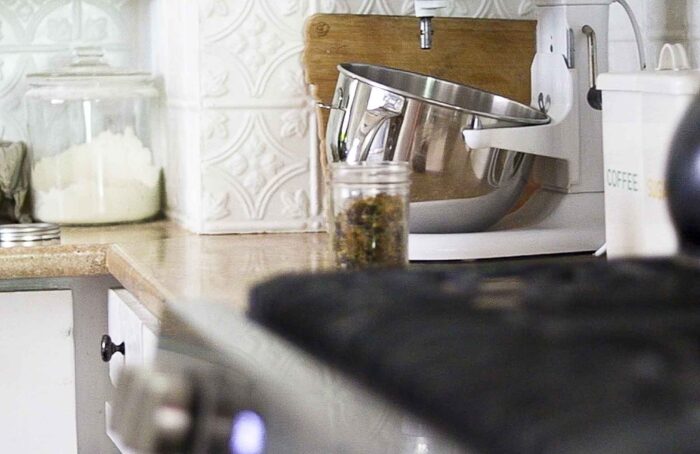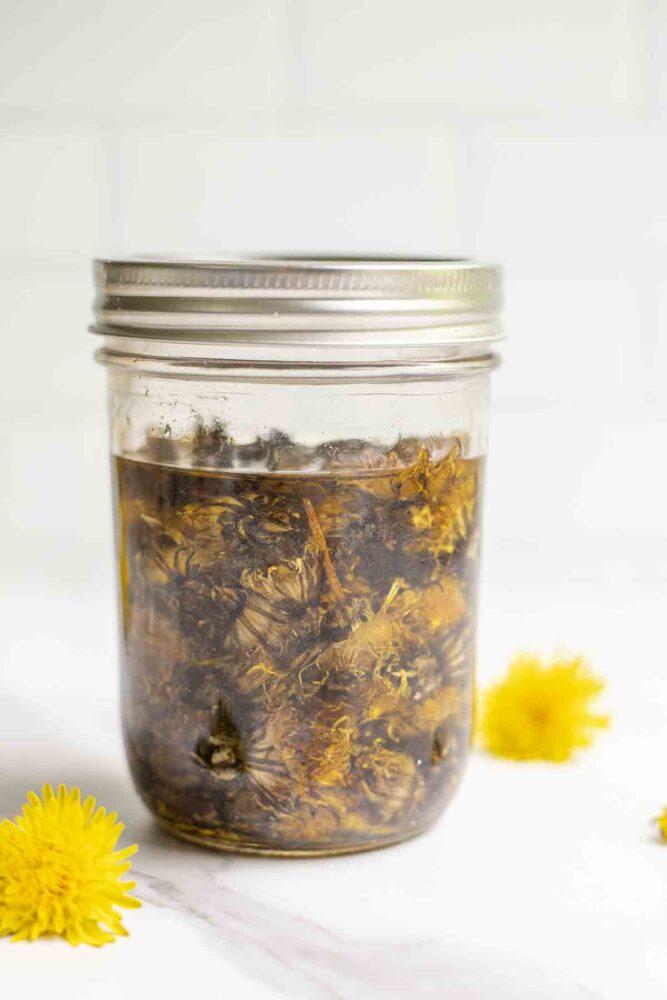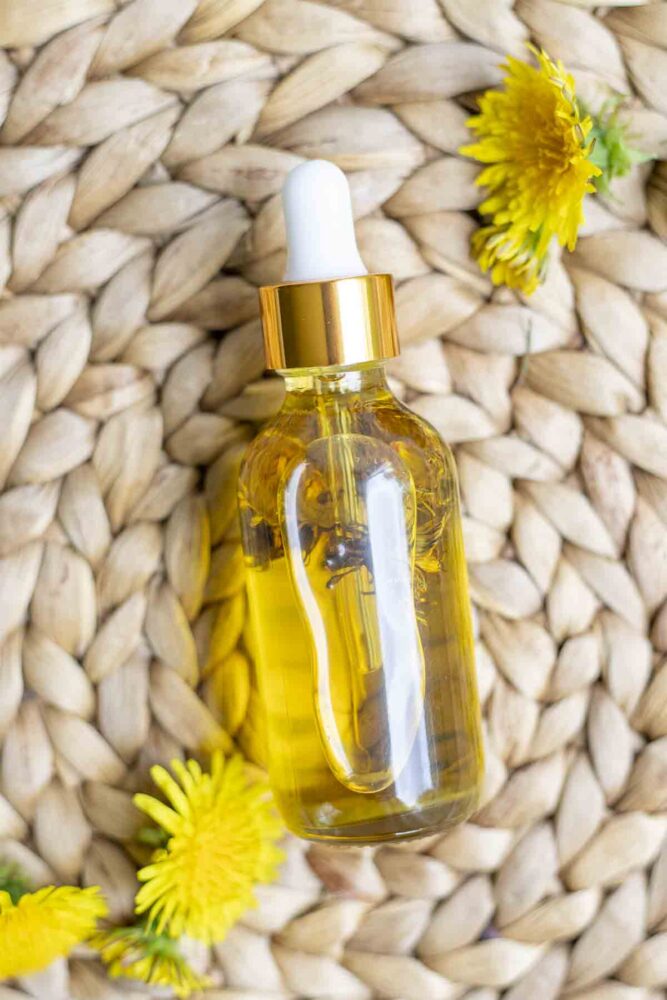How To Make Dandelion Oil
This post may contain affiliate links. Read disclosure policy.
Learn all about dandelions, their health benefits, and how to make dandelion oil – a nourishing and natural product for skin and hair care that smells like springtime all bottled up.

My little ones love to pick dandelions for me. No stems, no bouquet, just a fistful of dandelion blossoms that I’m instructed to place in water. Maybe yours do the same.
As kids, we also saw dandelions and thought “flowers”. I probably brought my mom some in just the same way.
Then we became adults and were told they were weeds.
These days, dandelions are being sprayed with pesticides for the perfect, green lawn. While I’m not here to argue with that, we are certainly not spraying our grass with pesticides. We also let the kids blow the dandelion seeds into the wind. We’re rebels.
Sometimes I will remove them with this handy tool if they are in a place that just isn’t helpful — like the garden. But otherwise, I like to leave them for the bees.
As such, we have an abundance of dandelions, whether you see that as a blessing or misfortune.
So what do we do with them?
Foraging Dandelions
Considering that blackberries literally grow like weeds here, and rose bushes are also abundant, let me share with you my passion for using the natural resources around me.
I’ve harvested and preserved blackberries, while also using them in recipes like blackberry banana breakfast bread, easy blackberry cobbler, and blackberry enchilada sauce.
With the roses, you’ll find me gathering rose petals for rose water, rose tea, and maybe adding some to homemade soaps or dried sachets.
So very similarly, you’ll find me plucking these useful little dandelion heads for my own purposes. Which, today, happens to be dandelion oil! It’s simple, soothing, and smells lovely and fresh.
Dandelions are a highly misunderstood and underutilized backyard plant. They actually have a lot to offer!
They are edible nearly from top to bottom — though eating the stem is typically not recommended, as it contains a bitter liquid that simply isn’t pleasant.
But the flower heads, the leaves, and the roots are all edible, rich in vitamins, and if properly prepared, an enjoyable supplement to your diet!
Benefits of the Dandelion

Dandelion is a multi-purpose herb, offering skincare benefits and many medicinal properties.
Some sources claim dandelion consumption, tea or otherwise, may help to ease heartburn, aid in digestion, regulate blood sugar, reduce cholesterol, and boost immunity.
Application of dandelion to the skin can help provide some relief to achy sore muscles or stiff joints.
The anti-inflammatory properties in a dandelion oil or salve may help with bee sting inflammation while also providing pain relief, as well as easing itchy skin due to bug bites or other skin irritations.
Overall, including dandelion in your diet or routine seems to offer some significant benefits. (source)
How to Use Dandelion Oil
Facial cleanser: It is an excellent cleanser, while also providing nourishment for your skin (perfect for the oil cleansing method). It’s particularly helpful for those with sensitive skin, as it has anti-inflammatory properties. Since it’s high in antioxidants, it’s also helpful for reducing the appearance of wrinkles.
Massage oil: Work this oil into your skin around stiff joints or achy muscle tissue. It’s soothing and also great for dry skin.
Add to soaps, lip balms, or homemade body butter: Adding dandelion oil to your homemade skin care products will offer great moisture and soothing properties, resulting in softer skin and less inflammation and redness.
Rub into hair: Dandelion oil may help stimulate hair growth and hair health.
Dandelion salve: An ultra-moisturizing product for dry skin, muscle aches, etc, dandelion oil can be combined with shea butter and a few other simple ingredients to produce dandelion salve.
Diaper rash relief: Sooth your baby’s bottom with this nourishing herbal remedy.
Drying Dandelions
Air-dry: Spread out the dandelion flowers on a flat, clean surface exposed to direct sun and airflow. I like to lay them on top of a tea towel.
Allow to dry for several days, depending on the size of the flowers and the amount of space in between them. Once fully dried, store in an airtight container. This free method works perfectly well.
Dehydrator: Arrange your dandelions on the dehydrator trays, setting the temperature to low — somewhere between 95 and 115 degrees Fahrenheit or so.
Dry for 4+ hours, rotating trays occasionally, and checking for dryness.
Oven-drying: Heat oven to 300 degrees Fahrenheit. Arrange the flower heads on a cookie sheet pan. Once preheated, turn the oven off.
Save This Recipe
Set the tray of flowers in the oven, keeping the door cracked, and leave the flowers for 2 hours. They should be brittle, but still maintaining color.
Types of Carrier Oils
Here are some options for your base oil, with some health benefits of each. Any of them would be a great choice of oil!
Olive oil: Quality olive oil, particularly extra virgin, is full of antioxidants and healthy fats and fosters heart and brain health, as well as potentially lowering cancer risk. (source)
Hemp oil: Hemp oil has been known to improve heart and skin health with its anti-inflammatory properties, and may aid in lowering cholesterol levels. Hemp oil may also contribute to lowering blood pressure, which could be problematic for those with already low blood pressure. (source)
Jojoba oil: High in antioxidants and vitamin E, jojoba oil is an effective moisturizer and multi-purpose oil for good skin health. (source)
Avocado oil: Avocado oil is packed with nutrients and healthy fat, making it an excellent oil for moisturizing, improving heart health, and even contributing to good eye health. (source)
Almond oil: A high-quality, unrefined almond oil is full of healthy fats and vitamin E, acts as an effective and soothing moisturizer, and is linked to increased heart health, stable blood sugar, and even weight loss. (source)
Fractionated coconut oil: This option is similar to regular coconut oil, though is more processed due to the lauric acid being removed, leaving it in liquid form even when refrigerated. Coconut oil contains antioxidants and is soothing to the hair and skin, adding moisture and preventing dryness. (source)
Tools You May Need
Saucepan or double boiler
Clean jar
Metal mesh strainer
Ingredients
Dried dandelions: See above recommendations for drying.
Base oil – find a starter list above!
Essential oils (optional) – Depending on the benefit you are looking for you can change up the essential oil. Add lavender for a calming benefit, or tea tree for anti-bacterial etc.
How to Make Dandelion Oil

Instructions for slow, no-heat infusion:

Step 1: Place roughly two cups of dry flowers into your jar.

Step 2: Pour the base oil over the blossoms, covering them. Cover with an airtight lid and set aside to steep for 3 weeks.

Step 3: After 3 weeks, strain the flowers from the oil with a fine mesh strainer and add to a glass jar.

Step 4: Optional: You can add a few drops of your favorite essential oil at this point. Store in a cool, dark place for up to a year.
Instructions for quick, heated infusion:
Add dried flowers to a small saucepan over low heat.
Cover the blossoms with your oil of choice.
You don’t want to simmer or boil, just a very low temperature.
If your stove is too hot even on low, you could use a double boiler, adding the flowers and oil to the top pan and water in the bottom pan.
Steep for 3-4 hours.
Strain the oil infusion into a glass jar.
You can add essential oils at this point.
Cover with an airtight lid and put it to use!
Storage
Store in a cool, dark place to preserve the oil. You can also refrigerate it. Check from time to time for freshness. Dandelion oil usually lasts between 6 and 12 months.
Tips
- When you harvest dandelions, make sure they are chemical and pesticide-free. Stay away from high-traffic areas, such as along roads, sidewalks, public parks or other places that may have been sprayed.
- For this recipe, I harvest the blossoms only. Leaving the plant intact ensures future flowers.
- Dandelions must be dried before being used in an oil-based product. If water from the fresh flower is present in the infused oil, it may introduce bacteria into the oil resulting in it spoiling.
- You can store a larger batch of dandelion oil in a quart jar, or distribute between some small jars. This is particularly helpful if you are gifting any to friends or family. Wrap with twine and a dried dandelion!
- Dandelion oil is meant for topical use. Dandelion leaves may be steamed and eaten, dandelion flowers are great for tea, and dandelion root can be roasted in the oven or dried and made into tea. For another herbal tea option, try this rosemary tea.
FAQ
You can apply directly to skin as a cleanser, moisturizer, or natural remedy for bug bites and sunburn, among other uses. You can also add it into other homemade products.
While dandelion is considered to be safe for most people, there is always the potential of someone not having tolerance for it. If using topically and skin irritations appear, discontinue use. If dandelion oil is consumed and followed by heartburn, stomach irritation, diarrhea, etc, discontinue use and consult a medical professional.
Yes, dandelion oil is safe for applying to the skin. It is cleansing, soothing, and nourishing to the skin.
Being high in antioxidants and vitamins like A, C, and E (plus the health factors of the oil you choose for this infusion), dandelion oil promotes skin cell production, encouraging healthy skin and lessening the appearance of lines or wrinkles.
More natural homemade products:
- Homemade Garlic Salve
- DIY Armpit Detox
- Nourishing Avocado Mask
- Homemade Bubble Bath
- DIY Nourishing Lotion Bars
- Lilac Syrup
Tried this recipe and loved it? I would love if you would come back and give it 5 stars. Please and thank you! Tag me on Instagram @ablossominglife

Dandelion Oil
Save This Recipe
Equipment
- Jar
Ingredients
- 2 cups dried dandelion flowers
- 1 cup oil or more
Instructions
Instructions for slow, no-heat infusion:
- Place roughly two cups of dry flowers into your jar.
- Pour the base oil over the blossoms, covering them.
- Cover with an airtight lid and set aside to steep for 3 weeks.
- After 3 weeks, strain the flowers from the oil with a fine mesh strainer and add to a glass jar.
- Optional: You can add a few drops of your favorite essential oil at this point.
- Store in a cool, dark place for up to a year.
Instructions for quick, heated infusion:
- Add dried flowers to a small saucepan over low heat.
- Cover the blossoms with your oil of choice.
- You don’t want to simmer or boil, just a very low temperature.
- If your stove is too hot even on low, you could use a double boiler, adding the flowers and oil to the top pan and water in the bottom pan.
- Steep for 3-4 hours.
- Strain the oil infusion into a glass jar.
- You can add essential oils at this point.
- Cover with an airtight lid and put it to use!
Notes
- When you harvest dandelions, make sure they are chemical and pesticide-free. Stay away from high-traffic areas, such as along roads, sidewalks, public parks or other places that may have been sprayed.
- For this recipe, I harvest the blossoms only. Leaving the plant intact ensures future flowers.
- Dandelions must be dried before being used in an oil-based product. If water from the fresh flower is present in the infused oil, it may introduce bacteria into the oil resulting in it spoiling.
- You can store a larger batch of dandelion oil in a quart jar, or distribute between some small jars. This is particularly helpful if you are gifting any to friends or family. Wrap with twine and a dried dandelion!
- Dandelion oil is meant for topical use. Dandelion leaves may be steamed and eaten, dandelion flowers are great for tea, and dandelion root can be roasted in the oven or dried and made into tea.


